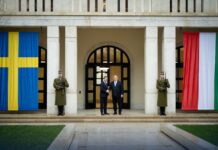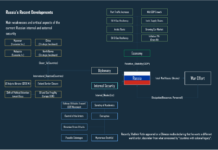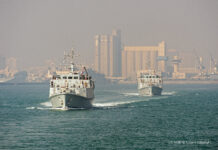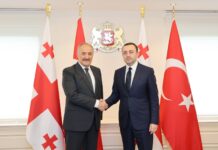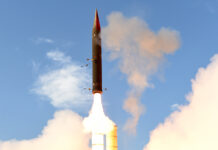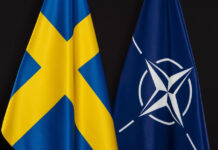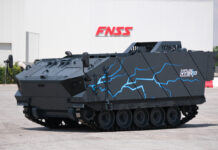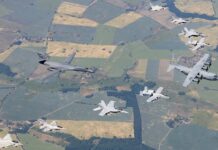Located between the Mediterranean and Black Seas, Turkey felt the need to embark on an indigenous helicopter programme. The result was the TAI T625 GÖKBEY first introduced in the summer of 2018, a twin-engined light transport/utility helicopter. Turkey’s Under Secretariat for Defence Industries plans to offer the new platform to the Turkish Armed Forces and cooperating nations.
Turkish Historical Context
Turkey has had its share of conflict over the years, from before the days of the Ottoman Empire to the Cold War, when Turkey held a vitally strategic position between the East and West, through the first Gulf War right up to the present day. It has been three decades since the end of the Gulf War / Operation Desert Storm when the allies also conducted operations from Incirlik and Bataan Air Bases against Saddam Hussein’s forces and later when protecting the Kurds during Operation Safe Haven, primarily using NATO rotary wing assets. Tension has always been present along Turkey’s borders. These have been exacerbated by the political struggles within Syria, the influx of refugees, and the threat from internal terrorist groups. Turkey has also unfortunately experienced its share of natural adversity as well, such as earthquakes, wildfires, and flash floods.
A Multitude of Platforms
The Turkish military and paramilitary helicopter fleet has a unique mix of American, European, and even Russian airframes across several military and paramilitary / airborne public service arms. The mix covers everything from the single-engine Bell 206B3 JET RANGER (for training), the Bell AH-1P COBRA, and the twin-engine Bell AH-1W SUPERCOBRA attack helicopter. In the battlefield and maritime role there are the single-engine Bell UH-1H, AgustaBell AB-205, to the twin-engine AgustaBell AB-212,
AB-412EP, Sikorsky S-70 (both land BLACKHAWK and naval SEAHAWK). The Airbus Helicopters AS532UL/AS532UT COUGARs are used for the Combat Search And Rescue (CSAR) role. Finally, Russian Helicopters MI17Iv is in service with the Jandarma (Gendarmerie) Aviation Directorate in the airborne public service role, alongside the Sikorsky S-70 and Bell 429 GLOBALRANGER.
During the IDEF 2021 defence show in the summer of 2021, there was an agreement for support of the Jandarma MI17 fleet between the Turkish Aeronautical Association and Ukrspecexport as part of a larger deal which involves potential maintenance of other MI17 aircraft in neighbouring countries. Recently, the Jandarma have added a dedicated attack helicopter role to their public state security role with the Turkish Aerospace T129 ATAK twin-engine dedicated attack helicopter.
In August 2021, as fires raged across the southern Mediterranean area, Oregon-based Erickson Aircrane provided one of their orange-red heavy lift S-6AE Aircranes to assist the Turkish authorities’ rotary wing assets in combatting the fires alongside the para-public and military helicopters. The Turkish General Directorate of Forestry themselves operate the Sikorsky S-70i BLACKHAWK and Bell 429 GLOBALRANGER.
Global Co-operation
Turkish Aerospace is involved in some of the major rotorcraft manufacturing programmes globally. Turkish Aerospace Aerostructures Division manufactures the body and canopy for the AgustaWestland AW139. For the Airbus Helicopters AS532, Turkey is the largest operator with 28 helicopters assembled by then EUROTAI – a TUSAS Aerospace Industries/Eurocopter joint venture divided between the Air Force and Land Command around two decades ago. Turkish Aerospace makes the fuselage, tail cone canopy, engine cowlings and rear doors for the COUGAR. On the Sikorsky S-70 series, the empennage, tail cone, rotor pylon, stabiliser and centrebox are all manufactured in Turkey. The company is also distinguished as a Centre of Excellence for the S-70.
The Helicopter Group of Turkish Aerospace is involved in two major co-operative projects and has been involved in various helicopter programmes over the years. These include manufacturing under licence or co-operating in the production of helicopters. The prime example is the T129 ATAK attack helicopter. This was developed in conjunction with Leonardo Helicopter Division, based on their AW129 MANGUSTA (MONGOOSE) attack helicopter. The T129 ATAK is currently entering service with the Turkish Land Forces (Turk Kara Kuvvetleri) Aviation Command, complementing the attack helicopter fleet already featuring the Bell AH-1W SUPERCOBRA and AH-1S COBRA.
The classic icon from the Vietnam War was the single- and twin-turbine engine Bell UH-1 IROQUOIS, more affectionately known as the ‘HUEY’ across the armed services of the United States during the conflict. Many variants were exported and built under licence throughout the world. Turkey was a major customer of both the single-engine Bell 204/205/UH-1H and the Italian AgustaBell variants, such as the AB-204/5 and the twin-engine AB-212 and four-blade AB-412EP.
The Turkish Indigenous Helicopter Programme
In 2013, the Under Secretariat for Defence Industries (SSB) and Turkish Aerospace signed a contract which saw the Helicopter Group begin work on the Turkish Indigenous Helicopter Programme.
This six-tonne airframe was mainly aimed at replacing the fleet of the above legacy helicopters across the Turkish Air Force, Land Forces Aviation Command, and the Gendarmerie General Aviation Command. There is also scope for the T625 to replace the Agusta Bell AB-212 and AB-412 in both the Navy and Coast Guard Command.
One major requirement of the new helicopter is the ability to operate in hot and high altitude conditions while providing high levels of comfort and safety to the operator/customer.
At the outset, the Turkish Indigenous Helicopter Programme was known as the Ozgun. At the beginning of 2017, the Turkish Aerospace Industries Helicopter Group officially designated the helicopter as the T625. This five-bladed, 14 seat (two pilots and 12 passengers), multi-role helicopter has a large cabin. The very size and capacity will easily be able to accommodate the variety of missions and roles intended. These include:
- airborne law enforcement
- transportation
- cargo
- VIP/corporate
- offshore
- Emergency Medical Services
- Search and Rescue (SAR)
Production of the T625 airframe began in the summer of 2016 with the first metal cut designed. The airframe was produced with the goal of providing better fuel consumption, subsequently leading to longer endurance and range. One example in the airframe design and production of this is the use of a retractable landing gear.
The Heart of the T625
The T625 will be expected to operate in hot and high altitude conditions so the aircraft has a Max Take Off Weight (MTOW) of 6,050 kg (13,337 lbs) while being able to operate up to a maximum ceiling of 20,000 ft or 6,096 m. The T625 is powered by a pair of Light Helicopter Turbine Engine Company (LHTEC) CTS800-4A. It is capable of performing at single-engine operation at Category A standards, adding the safety element during One-Engine Inoperability (OEI). This engine is a joint venture between Honeywell and Rolls-Royce and runs at 1,373 hp each, thus marking the first time a civil helicopter is powered by this engine. The CTS800-4A powers the T129 ATAK as well.
Touch Screen Technology
The trend for today’s modern aircraft cockpit is predominantly an all-glass cockpit. Turkish avionics company Aselsan provides the avionics suite for the T625. This includes the glass cockpit which has two wide touch screen (8×20 inches) Integrated Mission Displays, plus two touch screen (8×10 inches) data entry Touch Command Control Units. There is also a four-axis dual redundant automatic flight control system. This has been developed to provide superior performance and handling quality.
The GÖKBEY General Purpose Helicopter
The signing of the Indigenous Helicopter Programme Contract also led to the creation of the Rotary Wing Technology Centre (DKTM), which was established at the Middle East Technology University (METU) Technopark Facility. The DKTM facilitates Research & Development efforts, and technological acquisition amongst other activities. Both the SSB and Turkish Aerospace identified several areas of interest that align with their Rotary Wing Technology Roadmap.
The T625 started to take shape in 2016 with the cutting of the metal for the airframe and the development of the gearbox and transmission. The first flight took place on 6 September 2018 at 06:00 hours. On the 12 December 2018, the T625 was named GÖKBEY (meaning Sky Lord) by Turkish President Recep Tayyip Erdoğan. The T625 is waiting to be certified by both the Turkish Civil Aviation General Directorate (SHGM) and the European Aviation Safety Agency.
Wings of the HAWK
Like the famous Bell UH-1 HUEY, its development and replacement post-Vietnam is the Sikorsky S-70 BLACKHAWK. For almost three decades, the Turkish Armed Forces have operated the S-70/UH-60 variant in their Land Forces, Jandarma, and National Police. This is in addition to the naval variant (S-70B SEAHAWK) in the Navy.
Turkish Aerospace are involved in modernisation programmes for the rotary wing platforms across the Turkish Armed Forces. These capabilities are mainly avionics-based such as:
- Modular Integrated Avionics Architecture
- Growth Capability
- Multiple Operating System and Hardware Support
- Integrated Mission Planning Systems
The 10-Tonne Project
The Turkish Land Forces aviation element has entered the heavy lift role in the last couple of years, operating the new Boeing CH-47F CHINOOK to provide heavy lift across the armed forces. However, one of the current major projects for Turkish Aerospace is the development of a 10-tonne heavy lift helicopter. This is intended to be a general-purpose airframe, primarily for troops. It will also be easily adapted for SAR in both short and long range (offshore/coastal) roles. The design will feature a retractable undercarriage, rear loading ramp, and enough headroom for personnel to stand up. It is intended to fly at a speed of 315 km/h (170 knots) carrying 20 fully-equipped troops and will subsequently have a range of up to 1,000 km (621 miles).
The HAWK and Heavy Future
There are still many exciting projects ahead of the Turkish Aerospace Rotary Wing Division. The Turkish Utility Helicopter Programme (TUHP) designated T70, is a development based on the Sikorsky S70i. Over the next decade more than 100 aircraft are expected to be manufactured and delivered across the:
- Turkish Air Force
- Land Force
- Special Forces
- the National Police
- Gendarmerie
- Turkish General Directorate of Forestry
In 2014, the Turkish authorities signed a contract with Turkish Aerospace and their sub-contractors to manufacture the TUHP; two years later, Sikorsky themselves accepted a S-70i airframe from their Polish subsidiary for the TUP programme. It is expected that a total of 190 T70 aircraft will be built. 109 of which will be delivered over a decade to both the Turkish military and para-public operators. In November 2019, Turkish Aerospace unveiled the first locally assembled T-70.
Turkish Utility Helicopter Programme History
Though initially the TUHP tender started in 2007 with then AgustaWestland AW149 and the Sikorsky S-70 BLACKHAWK as candidates, the winner was to provide an initial batch of 109 aircraft under a US$4Bn contract. During the bi-annual Farnborough Airshow in 2010, AgustaWestland exhibited a mock-up of the proposed TUHP-149 in the Finmeccanica pavilion. However, in April 2011, the Turkish Defence Ministry announced that the winner was the Sikorsky S-70 BLACKHAWK.
TUSAS Industries Inc. is the prime contractor for this programme, but there are other subcontractors involved. These include Sikorsky Aircraft, Aselsan, TEI and Alp Aviation. TUSAS, as the main manufacturer, is responsible for final assembly, tests and logistic support overall.
TEI will build the engines under a licence from General Electric. Aselsan, an avionics and navigation specialist, will co-develop the enhanced digital cockpit, known as the Integrated Modular Avionics System, with Sikorsky. The production of dynamic components, such as the landing gear and gearbox, will be the purview of Alp Aviation.
Innovation has always been at the heart of the Turkish aerospace industry and its academia. Istanbul Technical University and Turkish Aerospace participated in a little-known project called Arikopter nearly two decades ago, backed by Turkey’s State Planning Organisation. International partners were rumoured to be Safran Helicopter Engines. The project was supposed to focus on the two-tonne class, with a crew of two pilots and six passengers. There was a projected first flight date for 2011, but it is now understood that the project has been halted.




